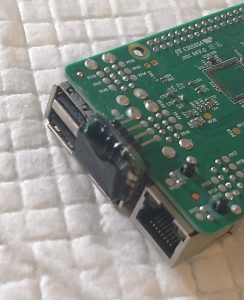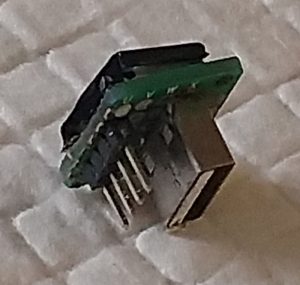Aug 2018:
On the time lapse camera, there was too much complexity in connecting the USB data lines from the female USB on the camera case to the USB data lines of the Raspberry Pi so I fashioned what I call a zero clearance USB adapter
that is inserted into the center lower USB connection on the back of the Raspberry Pi and the four pin header then connects to the female USB on the camera case. The 5 VDC lines from the female USB on the camera case is run directly to the Pi-EzConnect board
eliminating the acrylic sheet also gained some room on top of the Pi-EzConnect board for the future addition of the pan/tilt stepper motor controls.

To make the adapter I cut a rectangular opening, exactly the size of a male USB A, in some .1 proto-board and placed a male USB connector through the opening and put the connector into one of the female USB connectors. Then I scratched a line on the same face of the USB connector as the plastic separator and on the outer side of the proto-board. I cut the metal shield just a bit on the inside of the line so the metal housing does not contact my connections. I reinserted the male USB into the female and on the outer side of the USB I soldered a wire between the two sides and the uncut face of the USB and the proto-board on the side away from the female connector. This secures the metal housing to the proto-board. Then I cut away the rest of the metal housing of the USB above the solder joint. I added the 4 pin header then as it is easier than waiting till the rest of the USB is exposed. The plastic insulator of the USB was carefully trimmed away to expose the metal of the USB connector. The four leads of the USB were soldered to the 4 pin header with wires placed as low on the USB as possible. The rest of the insulator and leads on the USB were cut away and a plastic film cover laid over it all to insulate it.
Now the USB can be inserted and connected and still clear the back of the fake camera housing.

